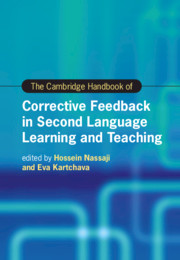Book contents
- The Cambridge Handbook of Corrective Feedback in Second Language Learning and Teaching
- Cambridge Handbooks in Language and Linguistics
- The Cambridge Handbook of Corrective Feedback in Second Language Learning and Teaching
- Copyright page
- Contents
- Figures
- Tables
- Contributors
- Acknowledgments
- Introduction Corrective Feedback in Second Language Teaching and Learning
- Part I Theoretical Perspectives on Corrective Feedback
- 1 Corrective Feedback from Behaviorist and Innatist Perspectives
- 2 Interactionist Approach to Corrective Feedback in Second Language Acquisition
- 3 Cognitive Theoretical Perspectives of Corrective Feedback
- 4 Corrective Feedback from a Sociocultural Perspective
- Part II Methodological Approaches in the Study of Corrective Feedback
- Part III Different Delivery Modes of Corrective Feedback
- Part IV Feedback Provider, Feedback Intensity, and Feedback Timing
- Part V Corrective Feedback and Language Skills
- Part VI Contexts of Corrective Feedback and Their Effects
- Part VII Learners’ and Teachers’ Feedback Perspectives, Perceptions, and Preferences
- Part VIII Individual Differences, Tasks, and Other Language- and Learner-Related Factors
- Index
- References
2 - Interactionist Approach to Corrective Feedback in Second Language Acquisition
from Part I - Theoretical Perspectives on Corrective Feedback
Published online by Cambridge University Press: 26 February 2021
- The Cambridge Handbook of Corrective Feedback in Second Language Learning and Teaching
- Cambridge Handbooks in Language and Linguistics
- The Cambridge Handbook of Corrective Feedback in Second Language Learning and Teaching
- Copyright page
- Contents
- Figures
- Tables
- Contributors
- Acknowledgments
- Introduction Corrective Feedback in Second Language Teaching and Learning
- Part I Theoretical Perspectives on Corrective Feedback
- 1 Corrective Feedback from Behaviorist and Innatist Perspectives
- 2 Interactionist Approach to Corrective Feedback in Second Language Acquisition
- 3 Cognitive Theoretical Perspectives of Corrective Feedback
- 4 Corrective Feedback from a Sociocultural Perspective
- Part II Methodological Approaches in the Study of Corrective Feedback
- Part III Different Delivery Modes of Corrective Feedback
- Part IV Feedback Provider, Feedback Intensity, and Feedback Timing
- Part V Corrective Feedback and Language Skills
- Part VI Contexts of Corrective Feedback and Their Effects
- Part VII Learners’ and Teachers’ Feedback Perspectives, Perceptions, and Preferences
- Part VIII Individual Differences, Tasks, and Other Language- and Learner-Related Factors
- Index
- References
Summary
The chapter outlines the interactionist approach to corrective feedback in second language (L2) acquisition. Input-providing and output-prompting feedback types are addressed, including their potential role in facilitating L2 development. Historical and contemporary interactionist research is overviewed, and suggestions are made for future work in this area. The chapter closes with pedagogical recommendations for the use of corrective feedback in L2 classrooms.
Keywords
- Type
- Chapter
- Information
- The Cambridge Handbook of Corrective Feedback in Second Language Learning and Teaching , pp. 44 - 64Publisher: Cambridge University PressPrint publication year: 2021
References
- 2
- Cited by

